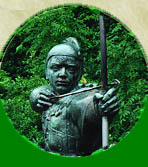
ROBIN HOOD
By Allen W. Wright
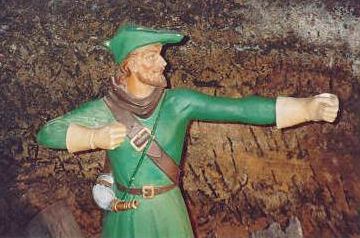
This page describes Robin Hood as he is now - after centuries of ballads, plays, books and movies have added to the story. The earliest surviving Robin Hood ballads date from the mid-15th century. If you want to know how the legend has changed over time, check out my Wolfshead Through the Ages: The History of Robin Hood section.
Riding through the royal forest of Sherwood on a glorious May morning, you
don't have a care in the world. Then you hear a bird call,
the faint rustling of trees, and suddenly a man armed with a
longbow appears in your path.
He wears a feathered cap, or is that a hood? You can't
see the man's face clearly, but you don't have to. He is
dressed in lincoln green, the colour of Robin Hood -- the most
famous English outlaw of all time.
Don't worry, he won't harm you -- not yet, anyway.
He'll invite you to join him and his outlaw band for a feast.
The meal of choice? Venison -- freshly-killed deer. Only a king
is allowed to hunt it, but then Robin never did worry about the
law.
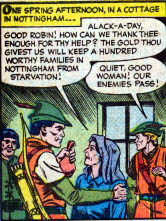 After your feast, Robin, or his faithful lieutenant Little
John, will ask you a question. How much money are you carrying?
If you answer truthfully, you may keep all that you have. If you
need money, then Robin will give or lend you some. But if you lie
to him -- if you hoard your money, well ... you won't have
that money for very long. You'll be stripped of your clothes
and cash, tied backwards on your horse and sent back to
Nottingham in shame. And your money? It will go to help someone
in need. After your feast, Robin, or his faithful lieutenant Little
John, will ask you a question. How much money are you carrying?
If you answer truthfully, you may keep all that you have. If you
need money, then Robin will give or lend you some. But if you lie
to him -- if you hoard your money, well ... you won't have
that money for very long. You'll be stripped of your clothes
and cash, tied backwards on your horse and sent back to
Nottingham in shame. And your money? It will go to help someone
in need.
Most people love Robin Hood. And that's a good thing.
Just as commoners are allowed to hunt harmful wolves, anyone can
hunt Robin Hood. The sheriff would pay for Robin's capture
just as surely as he would pay for a wolf's head. Robin and
his band are often called wolfsheads by their enemies.
Robin Hood is an outlaw. That means he lives outside the
protection of the law. But Robin is a law unto himself. He's
the self-styled king of the greenwood -- either Sherwood Forest
in Nottinghamshire or Barnsdale in Yorkshire.
Robin is no common criminal. As the famous saying goes, he
robs from the rich and gives to the poor. The poor have little to
fear from Robin Hood. His enemies are the rich and corrupt,
especially the Sheriff of Nottingham and the bad apples in the
Church like the Abbot of St. Mary's and the Bishop of
Hereford.
Robin defends the underdog against oppression.
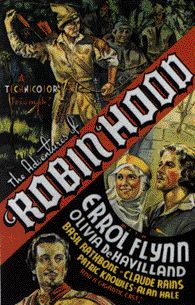 Sometimes he fights for the Saxons. The Saxons are better
known as the English, and for a time they lived under the cruel
domination of the Normans, the French-speaking descendants of
Vikings. In many modern stories, Robin fights for an England
where Norman and Saxon can live together in peace. Sometimes he fights for the Saxons. The Saxons are better
known as the English, and for a time they lived under the cruel
domination of the Normans, the French-speaking descendants of
Vikings. In many modern stories, Robin fights for an England
where Norman and Saxon can live together in peace.
Although Robin is an outlaw, a thief and a rebel, he is
usually a strong supporter of the rightful king, especially when
that king is Richard the Lionheart. Click to read about The King's Disguise and Friendship with Robin Hood. But Robin will fight
Richard's corrupt brother, the usurper Prince (and later
King) John.
In many stories, Robin is devoted to the Virgin Mary. But
in some versions, he is the "son" of the pagan forest
god Herne the Hunter. And others say he's one of the
"Fair Folk" or the "Little People", the
magical inhabitants of Britain.
But surely Robin's strongest allegiance is to his band
of Merry Men -- Little John, Friar Tuck, Will Scarlet, Much the
Miller's Son, Alan a Dale and above all Maid Marian, his true
love. You can read more about them in the Merry Men
section.
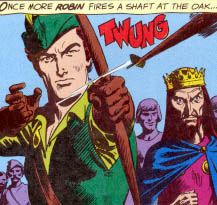 Robin Hood is a champion archer. Once, he snuck into a Nottingham
archery tournament. The prize for winning the contest was an
arrow with a silver shaft and golden head and feathers. It was a
tough contest. Some people say Robin's leading opponent shot
an arrow into centre of the target. It seemed impossible to beat
that shot. But bold Robin Hood took aim and shot an arrow
with such uncanny precision that it split his opponent's
arrow in two. Thus, Robin won the tournament and the gold and
silver arrow. Some tales say Robin can split a mere branch from
over 300 yards away. Click here to read the ballad Robin Hood and the Golden Arrow. Robin Hood is a champion archer. Once, he snuck into a Nottingham
archery tournament. The prize for winning the contest was an
arrow with a silver shaft and golden head and feathers. It was a
tough contest. Some people say Robin's leading opponent shot
an arrow into centre of the target. It seemed impossible to beat
that shot. But bold Robin Hood took aim and shot an arrow
with such uncanny precision that it split his opponent's
arrow in two. Thus, Robin won the tournament and the gold and
silver arrow. Some tales say Robin can split a mere branch from
over 300 yards away. Click here to read the ballad Robin Hood and the Golden Arrow.
He's also a good swordsman and handy with the
quarterstaff.
But for all this, Robin actually loses a lot of fights.
There are many stories where Robin meets a stranger, often a
simple tradesman like a potter, pindar, pedlar, tanner and so on.
Robin picks a fight. But the stranger often fights Robin Hood to
a standstill or even overpowers him. Robin then asks the stranger
to join his band. This is how many of the most famous Merry Men
met Robin Hood. Click here to read the ballad of Robin Hood and Little John.
When Robin lost to the potter, he traded clothes with the
potter and went to Nottingham to trick the sheriff into the
greenwood. In a similar story, he traded clothes with a butcher.
Robin Hood is a master of disguise. Dressed as an old woman he
tricked an evil bishop. As a palmer (pilgrim) turned hangman,
Robin rescued three of his men. And as a bold harper, he rescued
Alan a Dale's bride.
Click here to read:
Robin Hood and The Butcher
Robin Hood Rescuing Three Squires
Robin Hood and Allen A Dale
But who was Robin Hood before he became an
outlaw?
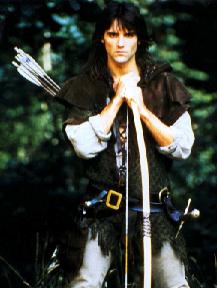 In the earliest tales, Robin Hood's name is Robin
Hood. But many stories say he was born in AD 1160 in the village
of Locksley or Loxley, which is sometimes in Yorkshire (as it is
in the real world) and other times in Nottinghamshire. So, Robin
is often called Robin of Locksley. Click here to read more about the locations of the legend.
In the earliest tales, Robin Hood's name is Robin
Hood. But many stories say he was born in AD 1160 in the village
of Locksley or Loxley, which is sometimes in Yorkshire (as it is
in the real world) and other times in Nottinghamshire. So, Robin
is often called Robin of Locksley. Click here to read more about the locations of the legend.
The earliest stories say he is a yeoman, a member of the
rising middle class. In the medieval ballads, no explanation is
given for why he is an outlaw.
But a well-known later tale has a bloody explanation for
Robin's outlawry. A tall lad of 15, Robin went to Nottingham
to attend a fair. He was stopped by 15 surly foresters who mocked
Robin's youth and said Robin was too young to shoot a bow.
Robin wagered 20 marks on his skill. Then, Robin shot and killed
a hart that was over 550 yards away. The foresters refused to pay
up and were going to beat up young Robin. But Robin managed to
shoot and kill all fifteen of them. For this, he was
outlawed. Click here to read the ballad where Robin Hood meets the foresters. Also, you can read how this story was adapted in the great 19th century children's novel The Merry Adventures of Robin Hood by Howard Pyle. Click here to read Pyle's prologue, where Robin is first outlawed and then encounters Little John.)
That story might be bloodier than some you are used to.
But the Robin Hood of the earliest surviving ballads also beheaded his enemies such as the
Sheriff of Nottingham and Guy of Gisborne. Click here to read the ballad Robin Hood and Guy of Gisborne. [However, depsite what has been said in some interviews promoting the 2010 film starring Russell Crowe, there is no record of a ballad actually called "Robin the Beheader" from the 9th or any other century. The earliest surviving ballads date from around 1460 AD, although the earliest surviving literary reference to legend is from circa 1377 AD.]
Some stories say Robin was outlawed when he rescued Much
the Miller's Son from the sheriff's men. Much was hungry
and had killed the king's deer. Under the harsh forest laws,
the foresters were to chop off Much's hand or remove his eye.
"Are there no exceptions?" Robin asked with an arrow
trained on the sheriff's men-at-arms.
Other stories say that Robin is the son of a forester. Or
that he is Sir Robin of Locksley, a knight who returned
from the Third Crusade to find his land stolen by the
sheriff.
And in some tales, he is the Earl of Huntingdon (or the
earl's son), a powerful land owner who loses his lands either
by going into debt or by betrayal. As the earl, Robin's real
name is sometimes said to be Robin Fitzooth, or the lord of
Locksley Hall.
In the television series Robin of Sherwood, Robin of Loxley is killed, and Robert of
Huntingdon becomes the second Robin Hood.
But however he became an outlaw, Robin does not remain an
outlaw forever.
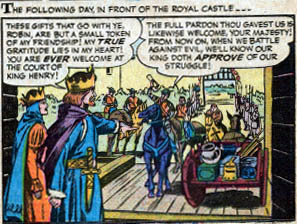 Many movies end King Richard pardoning Robin Hood. But in
the ballad version of this tale, Robin grows bored with service
to the king (called King Edward in an early ballad) and heads back
to the forest to live as an outlaw for another 22
years. Many movies end King Richard pardoning Robin Hood. But in
the ballad version of this tale, Robin grows bored with service
to the king (called King Edward in an early ballad) and heads back
to the forest to live as an outlaw for another 22
years.
In the ballads, Robin Hood and Marian do not have
children. But there are a few modern books, comic books and
movies with tales of Robin's daughter or son. (In the 2001 TV
movie Princess of Thieves, Robin's daughter is named
Gwyn.)
In 1247, Robin was ill and sought help from his cousin,
the Prioress of Kirklees. A common medical treatment in the
middle ages was to bleed someone. But the Prioress betrayed Robin
and drained too much of his blood away. Robin had just enough
strength to blow his hunting horn and summon his men. Little John
burst into the room, and threatened to kill Robin's
treacherous cousin. But Robin stopped his faithful friend. Robin
would never harm a woman.
Click here to read the ballad of Robin Hood's Death
Some stories say that Robin managed to shoot one last arrow
and the dying outlaw told Little John to bury him where it
landed. And near Kirklees is a grave that was said to belong to
Robin Hood. The date on the grave is "24 kalends December, 1247". It refers to the days counting back from the first (Kalends) of December. It's a forged and fake-medieval date, as it doesn't quite conform to proper Roman-style dating system. But it is apparently supposed to mean November 8. Others have set Robin's death day at November 18 (which would have been 14 Kalends December in true Roman style). And finally some have ignored the "Kalends" part and suggested that Robin died on Christmas Eve.
Perhaps Robin was killed that wintry day in 1247. But his
spirit remains alive -- whenever good friends gather or the
underprivileged need a champion. For centuries people have taken
the name of Robin Hood.
It may be a cliché, but Robin is not truly dead as
long as someone tells a tale of the bold outlaw of Barnsdale and
Sherwood.
So, raise a glass of the finest Brown October ale to Robin
Hood!
Note: The basic information on this page reflects the biography or life story of Robin Hood as the end result of centuries of storytelling. For a more advanced look at how the legend has changed over time, please visit the Wolfshead through the Ages section. For information on the candidates for a historical inspiration to the legend, check out the Search for a Real Robin Hood section.
Note: In case you're wondering, the "Robin Hood hat" is called a bycocket.
The Robin Hood Tales section features classic Robin Hood ballads that have formed the basis of modern children's books, films and TV shows.
If you're interested in Robin Hood Books, DVDs, etc - check out the Recommended Reading and Viewing section.
Note: The name "Robin Longstride" appears to be unique to the 2010 Robin Hood film starring Russell Crowe. However, Robin Hood has been depicted as a former Crusader in several versions, perhaps most notably in the 1976 film Robin and Marian.
NEXT: The Merry Men
|
